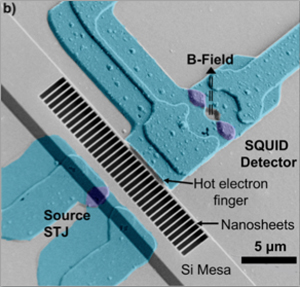Tiny tool measures heat at the nanoscale

How heat flows at the nanoscale can be very different than at larger scales. Understanding how surfaces affect the transport of the fundamental units of heat, called phonons, could impact everything from thermoelectric materials to microelectronic cooling devices.
Cornell researchers have developed a new way to precisely measure the extremely subtle movement of heat in nanostructures. Recently published online in Nano Letters and highlighted in Physics Today, the study features the researchers’ phonon spectrometer, whose measurements are 10 times sharper than standard methods. This boosted sensitivity has uncovered never-before-seen effects of phonon transport.
The scientists used the new instrument to directly measure the surface scattering of phonons in silicon nanosheets. They made nanosheets only 100 nanometers wide, which is 1,000 times thinner than a human hair, using special tools at the Cornell NanoScale Science and Technology Facility (CNF) – a key component in the success of their project, said senior author Richard Robinson, assistant professor of materials science and engineering.
The scattering of phonons on surfaces influences how well heat can flow through a structure. Similar to how light bounces off a lake, if a surface is smooth, phonons reflect off it, but when surfaces are rough phonons scatter in random directions, called diffuse scattering.
“If waters are calm you see a reflection, but in choppy waters you see diffuse scattering,” said Jared Hertzberg, the paper’s first author, a former postdoctoral associate. “This diffuse scattering slows down the transmission of phonons. This decrease in phonon transport becomes particularly important in nanoscale materials where surfaces play a larger role in the heat flow.”
Precise experimental techniques for probing phonon surface interactions – which depend on surface roughness and phonon wavelength – are lacking, Robinson said.
“The fundamental science of heat flow is not as well understood in nanostructures as it is in bulk materials,” Robinson said. “If we can precisely understand how this process works, then we can begin to engineer heat flow at the nanoscale, which can lead to more efficient alternate energy applications, such as thermoelectrics, or advanced phononic heat-logic circuits. We’ve just scratched the surface, so to speak, of how heat behaves at the nanoscale. There’s so much more to learn, and so much more that can be done with these phonons now that we know how to spectroscopically measure them.”
The researchers fabricated silicon nanosheets and measured phonon transmission rates with their spectrometer, and gauged the nanosheets’ surface roughness using atomic force microscopy. By comparing transmission rates with those predicted by theory, they could assess the validity of a 50-year-old theory called the Casimir-Ziman theory, which determines the probability of phonon scattering based on surface roughness and the phonon’s wavelength. While a perfectly smooth surface will reflect phonons perfectly, and a perfectly rough surface randomly scatters phonons in all directions, real surfaces fall somewhere in between.
Yet the scientists found, in fact, that the total diffusive scattering occurred at much lower frequencies than had been previously predicted by the Casmimir-Ziman theory.
Since diffusive scattering effectively lowers phonon transmission, high phonon scattering rates have implications for thermal conductivity in nanostructures: The actual thermal conductance will be much lower than predicted using the standard Casimir-Ziman theory.
The paper, “Direct Measurements of Surface Scattering in Si Nanosheets using a Microscale Phonon Spectrometer: Implications for Casimir-Limit Predicted by Ziman Theory,” also co-authored by graduate students Mahmut Aksit and Obafemi Otelaja and Derek Stewart, a CNF senior research associate, was supported by the National Science Foundation and the Department of Energy, Office of Basic Energy Science.
Media Contact
Get Cornell news delivered right to your inbox.
Subscribe